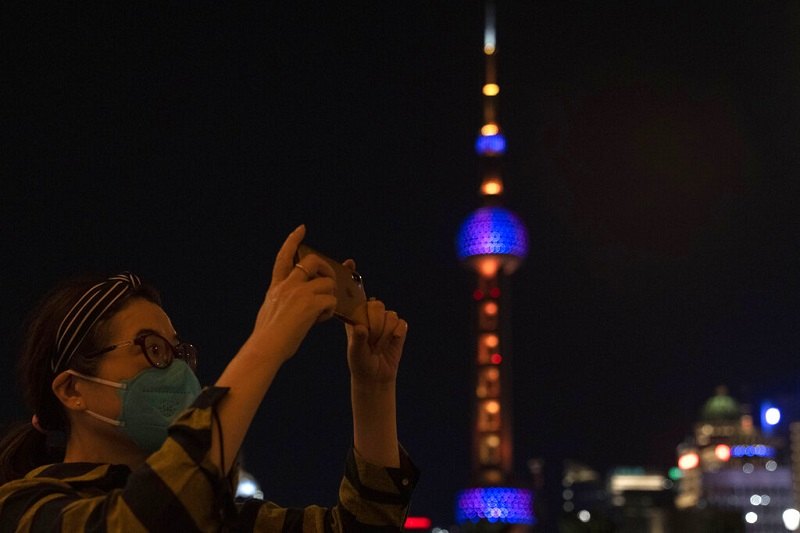
A woman takes photos near the Oriental Pearl Tower on the bund, Tuesday, May 31, 2022, in Shanghai.
11:15 JST, June 1, 2022
SHANGHAI (AP) — Shanghai authorities say they will take major steps Wednesday toward reopening China’s largest city after a two-month COVID-19 lockdown that has set back the national economy and largely confined millions of people to their homes.
Already, a steady stream of people strolled in the Bund, the city’s historic waterfront park, on a pleasant Tuesday night, some taking selfies against the bright lights of the Pudong financial district on the other side of the river. Elsewhere, people gathered outside to eat and drink under the watch of police deployed to discourage large crowds from forming.
Lu Kexin, a high school senior visiting the Bund for the first time since late March, said she went crazy being trapped at home for so long. “I’m very happy, extremely happy, all the way, too happy,” she said. “I could die.”
Vice Mayor Zong Ming announced that full bus and subway service will be restored on Wednesday, as will basic rail connections with the rest of China. Schools will partially reopen on a voluntary basis, and shopping malls, supermarkets, convenience stores and drug stores will reopen gradually at no more than 75% of their total capacity. Cinemas and gyms will remain closed.
“The epidemic has been effectively controlled,” Zong said. She added that the city will enter the phase of fully restoring work and life on Wednesday.
Officials, who set June 1 as the target date for reopening earlier in May, appear ready to accelerate what has been a gradual easing in recent days. A few malls and markets have reopened, and some residents have been given passes allowing them out for a few hours at a time. In online chat groups, some expressed excitement about the prospect of being able to move about freely in the city for the first time since the end of March, while others remained cautious given the slow pace and stop-and-go nature of opening up so far.
Workers took down some of the barriers that had been erected along sidewalks during the lockdown. A few people walked or biked on the still mostly empty streets. One man got his hair cut on the sidewalk, a common sight in recent days, as a worker or volunteer in full protective clothing looked on.
The most difficult part of the lockdown was psychological, said Cao Yue, who has worked in Shanghai for five years. She recalled the early days when it was difficult to buy food and she didn’t know what to do. “It was quite depressing to be locked at home and see the whole Shanghai under lockdown,” she said.
More than half a million people in the city of 25 million won’t be allowed out Wednesday — 190,000 who are still in lockdown areas and another 450,000 who are in control zones because they live near recent cases.
Shanghai recorded 29 new cases on Monday, continuing a steady decline from more than 20,000 a day in April. Li Qiang, the top official from China’s ruling Communist Party in Shanghai, was quoted as saying at a meeting Monday that the city had made major achievements in fighting the outbreak through continuous struggle.
The success came at a price. Authorities imposed a suffocating citywide lockdown under China’s “zero-COVID” strategy that aims to snuff out any outbreak with mass testing and isolation at centralized facilities of anyone who is infected.
Huge temporary facilities were set up in exhibition centers and other venues to house thousands of people who had tested positive. Teams of health care and other workers flew in from around the country to help run the massive undertaking.
Factories were shuttered, or were allowed to operate only if workers slept on site to prevent the spread of the virus. Reduced production at semiconductor plants added to the global chip shortage. Containers backed up at the port of Shanghai because of a shortage of truck drivers to deliver them to their destinations.
Though it all, leaders of the ruling Communist Party repeatedly expressed a determination to stick to the “zero-COVID” policy even as other countries have opened their borders and are trying to “live with the virus.” Outside economists widely expect China to fall short of its 5.5% growth target for this year.
However, the latest economic data showed that Chinese manufacturing activity started to rebound in May as the government rolled back some containment measures.
Schools will reopen for the final two years of high school and the third year of middle school, but students can decide whether to attend in person. Other grades and kindergarten remain closed.
Outdoor tourist sites will start reopening Wednesday, with indoor sites set to follow in late June, the Shanghai tourism authority said. Group tours from other provinces will be allowed again when the city has eliminated all high- and medium-risk pandemic zones.
Beijing, the nation’s capital, further eased restrictions Tuesday in some districts. The city imposed limited lockdowns, but nothing near a citywide level, in a much smaller outbreak that appears to be on the wane. Beijing recorded 18 new cases on Monday.
"News Services" POPULAR ARTICLE
-

American Playwright Jeremy O. Harris Arrested in Japan on Alleged Drug Smuggling
-

Japan’s Nikkei Stock Average as JGB Yields, Yen Rise on Rate-Hike Bets
-

Japan’s Nikkei Stock Average Licks Wounds after Selloff Sparked by BOJ Hike Bets (UPDATE 1)
-

Japanese Bond Yields Zoom, Stocks Slide as Rate Hike Looms
-

Japan’s Nikkei Stock Average Buoyed by Stable Yen; SoftBank’s Slide Caps Gains (UPDATE 1)
JN ACCESS RANKING
-

Keidanren Chairman Yoshinobu Tsutsui Visits Kashiwazaki-Kariwa Nuclear Power Plant; Inspects New Emergency Safety System
-

Imports of Rare Earths from China Facing Delays, May Be Caused by Deterioration of Japan-China Relations
-

University of Tokyo Professor Discusses Japanese Economic Security in Interview Ahead of Forum
-

Japan Pulls out of Vietnam Nuclear Project, Complicating Hanoi’s Power Plans
-

Govt Aims to Expand NISA Program Lineup, Abolish Age Restriction


























